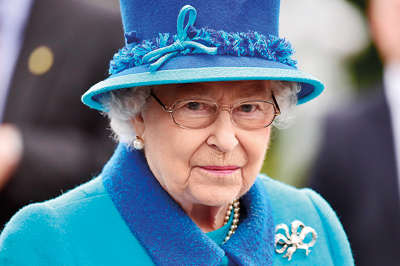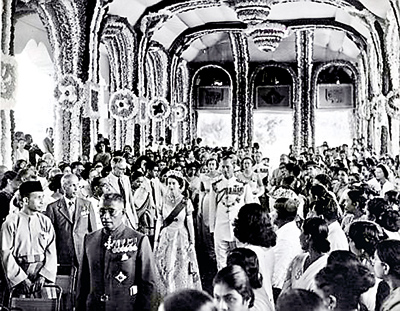A royal life, a royal reign
The life and reign of Queen Elizabeth II is one of astonishing statistics: the oldest sovereign of England and Great Britain; the longest married (almost 68 years); the most photographed and the most travelled sovereign in history.
To these are now to be added, the longest reigning sovereign, something which happened around 17. 30 on Wednesday September 9, 2015. On that date, Queen Elizabeth II passed the milestone reign of Queen Victoria, which was 63 years and 216 days.

“The Lady with the long cool stare”: Queen Elizabeth II at a ceremony at Tweedbank Station in Tweedbank on the Scottish Borders on September 9, to officially open the Borders Railway. Pic courtesy AFP
But who is this remarkable person? Queen Victoria herself was an extraordinary personage by any standards.
Indeed, her secretary Arthur Ponsonby once wrote this memorable memorandum: “She does not belong to any conceivable category of monarchs or of women…..She was not in the least like the three Queens regnant , her predecessors….moreover she reigned longer than the three Queens put together.
Never in her life could she be confused with anyone else, nor will she will be in history.” Could one say this about the present Queen? Almost certainly Yes.
The circumstances of her life and the times in which she has reigned, make her unique, with experiences and titles which cannot be repeated. For example, she was Queen of Ceylon (as it then was) from 1952 until 1972, a period of twenty years; and she was Queen of South Africa from 1952 until 1961, a period of nine years.
She has been also Queen of Ghana, Queen of Nigeria, and Queen of Malta, even if it was for much shorter periods. These titles will not be repeated.
The way in which she has been viewed is almost always in a rosy light. She seems to have an effect on people, to exert an unexpected fascination, in the way her great namesake did, of whom it was said “She has the spirit of incantation”.
While not expecting such Welsh mysticism in a constitutional Queen of the twentieth and twenty-first centuries, it is still extraordinary the effect she has on others.
Her British Prime Minister , James Callaghan, confessed that during a walk in Buckingham Palace gardens, she picked and gave him a bunch of violets, and from that moment he lost his heart to her; while another Prime Minister, Harold Macmillan, said, rather more soberly: “She means to be a Queen, and not a cipher”.

The scene in the Independence Hall, Colombo, as Queen Elizabeth II, with Prince Philip, arrived to open the Parliament of Ceylon on their 1954 tour. Courtesy DailyMail, London
Other revealing comments are “She loves being Queen” and “I really like the lady. Sweet person.
Good Queen” (said at the time of the Silver Jubilee in 1977). While at the same time even graffiti on the walls of the East End of London proclaimed: “Liz rules. OK”. The Queen herself perhaps prides herself as “The Lady with the long cool stare”.
Encrypted in her DNA is the ability, like Queen Victoria, to silence a room when she walks into it.
At the very beginning of her reign, on her Coronation day in 1953, the hardbitten and often cynical journalist, William Connors, who wrote for the “Daily Mirror” under the name Cassandra, fell under her spell.
After the Coronation, he wrote the following: “Empires may decline and material strength fade away, but this land of ours and this Commonwealth of ours yesterday reached a summit of unity we have never attained before. ..no human being has ever been scrutinised by such searching vigilance by such a vast audience as was the Queen.
Television, that mechanical, unforgiving eye, watched unceasingly. Every movement she made, apart from the sacred moments of the anointing, was laid bare before millions of staring eyes. Every expression in her eyes, every smile on her mouth, was recorded. ..and how superb she was.
To call her a great actress is blasphemy upon such an occasion. Yet great and accomplished actresses could not have bettered her on this the supreme day of her life. Every moment was a masterpiece of controlled poise….”
It is a commentary which could have been applied to Elizabeth I. Cassandra went on: “Yesterday was a consecration of our way of life. If this reign is as long as we hope it will be, many of us will never see another. But at least we can console ourselves with this thought.
There can never be another Coronation to excel this in beauty, in splendour and in natural, unaffected joy”. Certainly, nothing happened quite like this to previous sovereigns, although 400,000 people crammed into the capital to see something of the Coronation of Queen Victoria in 1838. But Queen Elizabeth II was equal to it, and to the 63 plus years which have followed.
After the Coronation came an extended tour of the Commonwealth and Empire, most of it getting ready for independence, something which had already happened to the Indian sub-continent and to Ceylon and Burma and Pakistan.
| Colonial ties Sri Lanka (then Ceylon) was a Crown Colony from 1815 to 1948 when the country gained Independence. Even then under the Soulbury Constitution the link with the British crown was maintained with the Governor General acting as the representative of the British monarch. The Queen’s title till 1972 in Sri Lanka was, “Her Majesty Elizabeth, the second, Queen of Ceylon and of Her other Realms and Territories, Head of the Commonwealth”. It was only in 1972 when the Republic of Sri Lanka came into being that the ties with the British monarch were shed. Sri Lanka is still a member of the Commonwealth and currently holds the Chair in office of this grouping of former British colonies. |
The highlight of the outward voyage was the visit to Ceylon, as it then was. The Queen opened both Houses of Parliament in April 1954, wearing her heavy Coronation robes, at the insistence of Sir John Kotelawala and his Cabinet.
Ceylon had stressed its loyalty to Britain and the Crown, while remembering perhaps its own native monarchies, such as the Kingdom of Kandy, which lasted until 1815.
The choreography of the Queen’s visit in 1954 was intended to stress those bonds of loyalty, as Philip Murphy has recently written in his important volume, “Monarchy and the end of Empire” in 2013.
Not only that, but the Coronation robes reflected the Commonwealth itself, being embroidered with the national symbolic flowers, including the lotus flower of Ceylon.
The Queen’s commitment to the United Kingdom and to the Commonwealth has been one of the enduring leitmotifs of her reign. At her Silver Jubilee speech in Westminster Hall in 1977, she said: “I cannot forget that I was crowned Queen of the United Kingdom of Great Britain AND Northern Ireland”, with the emphasis in the right place; and again, after the Scottish referendum in 2014 she issued a statement ,which was considered “nothing less than an appeal for reconciliation and calm”.
All of this is brought at a price. Cassandra the columnist again, after the Commonwealth Tour in 1953-4, said: “The Queen has been a woman royally at work. The first native dance you see is great rollicking fun. The second dance is great fun. The third dance is fun. The fourth is a native dance.
The fifth is just another of those darned dances; and the sixth is a kind of Terpischorean hell with the fires banked low. The Queen saw sixteen!” Yet the royal mask never slips (unless the Queen wins a horse race).
Control is all. Queen Victoria’s empire was vast, but she never saw any of it. Queen Elizabeth II has visited every part of it, some parts many times. She has ensured her place in history by becoming, through duty, the most respected person on the planet.
On a visit to South America, a young girl was heard to express astonishment when told that there were other queens on earth. “I thought that Queen Elizabeth was kind of Queen of the world” was her comment! Such impressions could only be achieved by her longevity combined with a long long life of service.
(Michael L. Nash is currently teaching at the University of East Anglia. His book, “The Strange & Secret History of Royal Wills” is to be published by Palgrave-Macmillan in 2016)


